#Southern Bavaria
Text
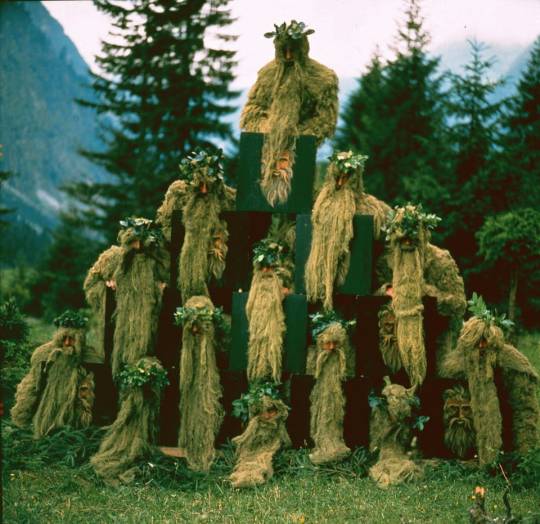
In Oberstdorf, an old village in Southern Bavaria, a unique ancient pagan tradition is still alive – the dance of the wild men (Wilde-Mändle-Tanz), which is held only in this small town, once in five years.
Wilde-Mändle-Tanz is dedicated to the Germanic god Thor, and involves 13 men, all of whom belong to old local families who have been living in that region for centuries. The men’s costumes are made of moss, which grows only in the Allgäu Alps.
They dance to rhythmic drum music, building a pyramid, and at the end they drink mead from their wooden mugs, singing a ritual song.
#Ancient Ways#Sacred Ways#Wheel of the Year#Oberstdorf#Southern Bavaria#ancient pagan tradition#customs#traditions#folkways#dance of the wild men#Wilde-Mändle-Tanz#German#Thor#God#costumes#moss#Allgäu Alps#dance#music#ritual
85 notes
·
View notes
Text




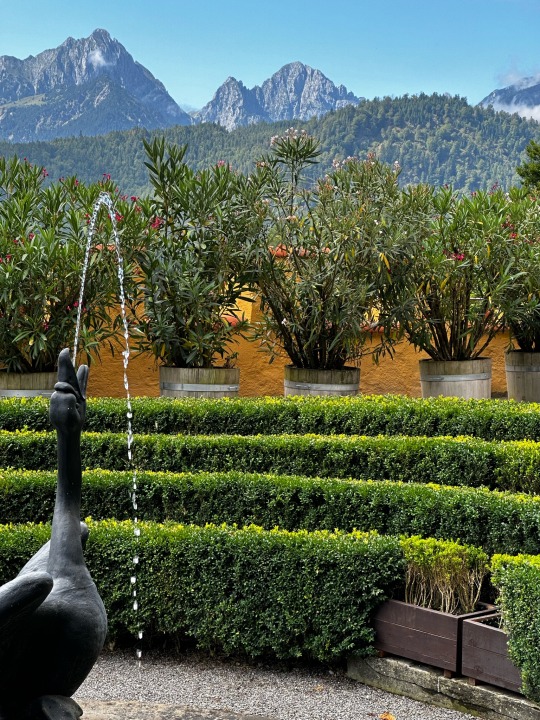





Visiting Hohenschwangau castle.
We decided to book tickets to see Hohenschwangau instead of Neuschwanstein. I think it was well worth it, not nearly as crowded as it could've been. We weren't allowed to take pictures inside the castle due to it being privately owned but what me and the family saw was nothing short of amazing.
There was also a really good view of Neuschwanstein from the courtyard that I got to witness (1st picture).
August 26th 2023.
#summer 2023#Schwangau#Hohenschwangau#Neuschwanstein#Schloss Neuschwanstein#Schloss Hohenschwangau#castle#Germany#Deutschland#Bavaria#Bayern#Southern Germany#mountains#German Alps#castle courtyard#cobblestone#nature#landscape#fountain#water fountain#tourist destination#Europe#Germany trip#Europe trip#vacation#family vacation#history#culture#tourist attraction#summertime
25 notes
·
View notes
Text
the worst part about making heisenberg actually german in my au (aside from the possible connection to nazis in ww2) is that while i can obviously have him curse in german, i absolutely CANNOT have him say "oh mein gott" because i KNOW every reader will read it in a little german boy voice
#re8#resident evil 8#karl heisenberg#and i know this because i myself read it in the little german boy voice#i'm still unsure about the ww2 shit because he does have german dog tags but are they his? whose are they?#it'd be funny if he wasn't from bavaria too so someone asks him about lederhosen and he's like#'don't associate me with the southerners'
63 notes
·
View notes
Text
ok i was kinda joking but princess tutu rlly is set in bumfuck bavaria yyeeessssssssssssssssss
13 notes
·
View notes
Text
no lie pentiment got me on that ancestry dot com free trial rn
#it’s bad for me#they shouldn’t have based that damn game in southern bavaria#any of those cunts could be related to me#but for realsies i’m learning a lot abt the paternal side of my family#nothing from the philippines tho 😭#zzz
4 notes
·
View notes
Text

early summer morning🩵
2 notes
·
View notes
Text
Ministry of education and cultural affairs PLEASE make your application process for a teacher job for people without a state examination and a teaching qualification but who are still allowed to apply for reasons you listed on your own fucking website easier I'm BEGGING
#this fucking application form is giving me a headache#no i did not study to become a teacher at a university#yes you literally listed a qualification as a foreign language correspondence clerk as sufficient to teach english yourself#does germany want teachers now or....?#please at least not transfer me to southern bavaria god i wanna stay up here where it's relatively cheap#mel talks
1 note
·
View note
Photo

Dance of the Wild Men (Wilde-Mändle-Tanz), folk ritual in southern Bavaria involving thirteen men in costumes made from moss found only in the Allgäu Alps
2K notes
·
View notes
Text

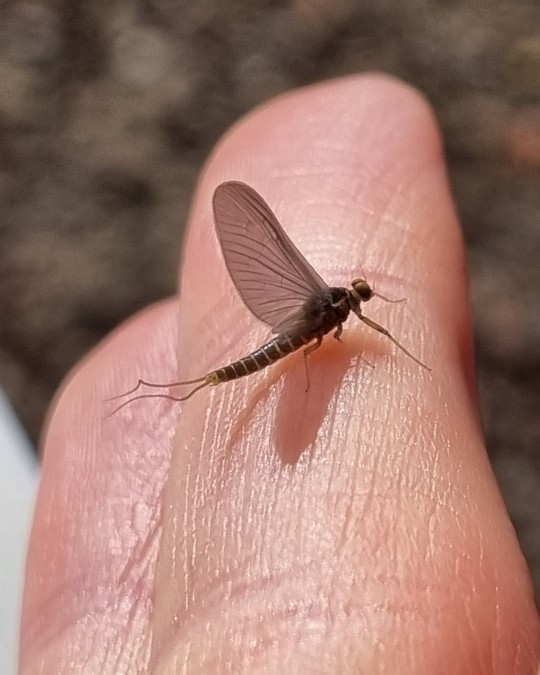
@thots-to-the-void submitted: Had this funky little fella seek shelter from the wind on my hand last week. Had a lovely time reading together till the wind subsided, found in southern Bavaria, Germany!
A male mayfly! I hope he successfully found a partner to make more mayflies before moving on to the great buggy beyond :)
143 notes
·
View notes
Note
Which language(s) do Vesna and the gang speak in canonically?
Thank you for the ask! The main characters all converse in Middle High German. The current story takes place in the 1240s, during the german Ostsiedlung, or "eastern colonisation;" Franzesca's family moved from Merania (between Innsbruck and modern southern Bavaria) to southern Bohemia, where most people would be speaking Old/Medieval Czech. Vesna and Snježana were born further north but raised in the household, and Vesna was never taught much Czech; Franzesca's father holds very serious anti-slavic views and prefers members of the household to speak German (this will become pretty important later on in the story).
Ljuba speaks Czech as her first language, and Franzesca knows French and some Latin.

(Unrelated bonus art)
#vesna#vdtwof meta#asks#vesna asks#thank you freyja#anyone who has good reading on the ostsiedlung#or general medieval slavic german relations#please send them my way thank you
58 notes
·
View notes
Text
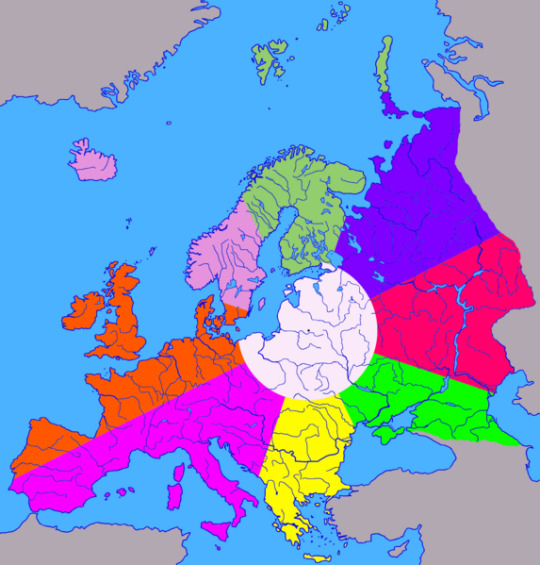
turns out when you use the center of gravity of the geometrical figure of europe, lithuania is by definition in central europe; southern europe includes the czech republic, bavaria, and the crimea; and western europe extends as far east as bosnia. also i think on this map moscow is in central europe?
#i'm taking northern/southern/eastern/western europe#as being overlapping groups of 3 segments#extending outward from the center point
59 notes
·
View notes
Text

I had the idea of writing about some historical queer figures I find interesting and drawing them for this pride month as a little project of mine. I will see how many I'll have time to do, I have in mind at least four other historical people, but knowing myself, I'm not holding my breath for all of them. Julie d'Aubigny she been one of my favorite historical figures for years so I decided to start with her.
Historical Queer Figures - Julie d'Aubigny
Julie d'Aubigny, also known as Mademoiselle Maupin and La Maupin, was a French opera singer and fencer in the late 1600s. She was infamous for having sapphic relationships, being aggressive and dramatic, having androgynous presentation by occasionally dressing in men's clothing in public and being a fencer and duelist. Trans and genderqueer readings of her are very possible, but because none of the accounts of her (at least those I've read) suggests she ever used any other than feminine first names or terms or she/her pronouns about herself, I will use she/her pronouns when talking about her.
The French court absolutely loved to gossip and people were constantly making up libel about the people they didn't like, and Julie had a lot of enemies and was very controversial figure. During the 18th and 19th centuries she was written about a lot in these highly sensationalized Encyclopedias, where the rumors from her lifetime got increasingly wilder and sensational. She was accused for example of seducing noble women in court balls, burning down a convent and murder. There's not much primary sources left or available from her actual lifetime so distinguishing truth from fiction is not an easy task in her case. Kaz Rowe did great job in their youtube video about her to try to actually find out where the stories of her life comes from. They go through some great context too about the rumor industry in the French court at the time so I highly recommend checking it out.
CW: very brief mentions of child sexual abuse and self-harming
The Timeline of Most Concrete Events
Let's first go through the things that have at least a bit more backing than a rumor started 100 years after her death. Julie d'Aubigny was born between 1670 and 1673. Her father was Gaston d'Aubigny, the secretary of Louis of Lorraine, count d’Armagnac, who was Master of Horses to King Loius XIV, and her mother is unknown. She was probably brought to the Versailles court in 1682, where she got a full education including academic subjects, riding and fencing, usually only thought for boys. She was married off to a Sieur de Maupin (first name unknown) probably around 1687, when she would have been 14 to 17 years old. He apparently got a position from a southern province as a tax collector. The stories about her claim she remained in Paris, but I don't think there's evidence of this, though what we do know of her adult life does suggest she was estranged from her husband and lived apart from him. Nevertheless, she did end up in Marseilles, where she first appeared on stage in Marseilles Opéra between 1687 and 1690. She didn't have education in music, but her good looks and beautiful voice landed her the role.
Her first appearances in the Paris Opéra are listed to 1690, so that is probably when she had her debut there. She became a very talked about figure and she gained both friends and enemies in the opera and the court. She performed in the Paris Opéra for probably four years, after which she went to Brussels, Bavaria, where she performed with the Opéra du Quai au Foin at least during 1697 and early 1698, after which she returned to France to perform again with the Paris Opéra.
It was the period when her career peaked and she got a lot of leading female roles. Those roles in French opera were at the time soprano roles, but Julie's natural voice range was lower, contralto. (There's a whole thing where at the time she was described as mezzo-soprano, but the music historian consensus is that her range matches contralto in modern terms as opera was sang on lower cords across the board at the time. (I understand nothing about music theory so I just hope I managed to explain this correctly)) She excelled in secondary female roles of goddesses and warrior women. For the leading roles she had to sing on higher notes than was natural to her and the naive and dainty personalities of those roles clashed with her own personality. Some later retellings of her life claim she performed male roles for female singers (which was common practice, and these roles were often those of young boys), but all known records of her roles are female roles. In 1702 on the leading composers of the Paris Opéra, André Campra, wrote her a leading lady role in Tamcréde, which is often credited to have the first leading female role for contralto. But her perhaps most famous role was as Médée in Medus, which was considered to be a very difficult role. Apparently the original leading singer had fallen ill before the debut so Julie was quickly trained in her stead, but succeeded well and got a lot of praise for the role.
In 1703 Julie started an affair with Madame la Marquise de Florensac, who was said to have been the most beautiful woman in France. This is the affair of hers of which there's most evidence. De Florensac was married and had children, but she was also rumored to have many affairs. Julie lived quietly together with her for two years. They were described by a contemporary to have lived in perfect harmony, always spending time together and only appearing in public when necessarily. Julie deputed in her last role in 1705 and ended her career after De Floransac died of sudden fever. Nothing concrete is known about the rest of her life, not even how or when she died, but she is usually speculated to have died in 1707.
Parsing History from Fantasy
Chronologically the rumor that places earliest in her life was that she had "an affair" with count d’Armagnac (age 46 at the time), before she got married in the same year so as a 14 to 17 year old. There doesn't seem to be any actual evidence of this and even if that really happened, it wouldn't have been an affair, it would have been grooming and sexual violence. Related to it is the rumor that the count arranged her marriage and sent her husband away, but kept her in the court with him. Then she "got bored" of the count and ran away with an assistant sword-master, Séranne, to southern France. They got money by performing fencing matches in fairs and taverns while they were traveling till they got to Marseilles, where she first appeared in opera.
The stories of her in this period are generally written in a super nasty tone, and she (as supposed 14 yo) is written as the seductress and the adult men are written as the victims of her fiery temper and fitfulness. All these stories seem pretty unlikely though. The rumor about the count seems (unfortunately) most possible, but accounts from 18th and 19th century about these early events in her life don't seem to be based on any information from her lifetime. I find it most likely that the writers in 18th and 19th centuries were filling out the blanks we don't know from her life and painting her as this (in their eyes) degenerate seductress from an early age. An alternative possible explanation could have been that she indeed accompanied her husband to south, perhaps near Marseilles, where she then performed with the Marseilles Opéra. Many sources claim though that she performed with her maiden name there, which would be odd if she was living with her husband. I don't know where that claim comes originally, but it could be false of course. Although the generally proposed year of her marriage could also be false, which would explain why she at first performed with her maiden name, and later in Paris and always after that with her husband's name. That would not explain how she ended up going to Marseilles though.
The next and perhaps the most infamous and coolest story of her sets somewhere shortly before 1690. In that story she fell in love with a girl in Marseilles and the girls parents sent her to a convent to avoid a scandal. Julie went to the convent with the premise of wanting to become a novice. They tried to frame the girl's death by putting a dead nun's body into the girls bed and setting it on fire and then went on the run for couple of months. While on the run Julie was sentenced to death in absentia, but after returning to Paris and rekindling her relationship with count d'Armagnac, he got the king to pardon her. As amazing as this story is, it's very likely not true. It seems quite unlikely that the 15 to 19 year old Julie would have done that, but even more unlikely that she'd just get all her charges dropped and these crimes wouldn't have hindered at all her career, which hadn't even properly begun yet. The first surviving description of this incident comes from a letter of her contemporary court lady, Madame Dunoyer, who was basically an early gossip columnist and despised her. Her story doesn't mention Julie at all, but talks about a nun, who tried to frame her own death in a similar manner to escape with her male lover (which still sounds very unlikely story). The first surviving description that attaches that story to Julie, comes year after her death from the very suspect writings of a known liar, Cardinal Debois, who did personally know and hate Julie. He claimed that Dumenil, who was an actor in Paris Opéra the same time as Julie, related him the story, while also acknowledging he probably did it because he too hated her. So very likely not a true story, but possibly something that was rumored during her lifetime already.
In the stories of her, after escaping from the convent and before going to Paris, she traveled again in male attire and met Louis Joseph d'Albert de Luynes von Grimberghen, commonly known as count d'Albert. He was an interesting character in his own right, roughly her age, and like her, his real story is a little hard to parse from the legend (though in his case, he was a nobleman so there's also a lot of actual records of his life). In the story though, he thought she was a man, they had some disagreement, a fight broke out, she won, injured him and nursed him back to health. And then they had a brief affair before d'Albert went to war again. They were lifelong friends, so this is not entirely made up. It's entirely possible they had a brief affair (and according to many stories an on and off type of affair that was re-kindled at many points in their lives) and there was rumors about it even in her lifetime, but the story of this first meeting seems to lack validity.
Next in her stories she met Gabriel-Vincent Thévenard, who was another famous singer and her contemporary, either right before or right after she arrived in Paris. They became lovers and after Thévenard auditioned and got accepted into the Paris Opéra, he helped to get Julie accepted too. It is true that as far as we know, they both debuted in 1690. They were also said to have been life long friends and again it's possible they were lovers at some point, but the details of their meeting are difficult to know.
There are many stories about her antics of both of her times in the Paris Opéra. In those stories she fought duels, assaulted Dumenil with a cane, robbed Dumenil, had fights with men after they insulted her or another women or harassed other women, tried to kill herself after her love was not reciprocated, threatened to shoot a duchess in the head, threatened to slit Cardinal Debois' throat, bit Thévenard in the ear on stage and had affairs with men and women. According to Cardinal Debois the feud between Dumenil and Julie started because Dumenil was interested in her but she rejected him. The Cardinal was a liar but it does sound pretty believable. So if it's true and he spread in retaliation a lie that she burned down a convent, her beating him up or beating him up, stealing his valuables and returning them to him by humiliating him in front of other actors, would align well with everything else told about her personality. Maybe her retaliation wasn't exactly as in the stories, but if the other things about Dumenil were true, I'm sure she retaliated in some way. Same applies to her threatening the Cardinal's life. He wrote about it, but he was a liar, but, but because he was a liar who lied about her, it sounds like something she might do. Madame Dunoyer wrote about her threatening the Duchess of Luxembourg apparently because of jealousy over count d'Albert. The duchess was d'Albert's mistress at one point and apparently he even fought a duel over her in 1700. So there is some validity to this rumor, though the circumstances were perfect to fabricate that kind of rumor. I haven't found as much backing to other rumors, but many of them sound possible or at least maybe rooted in some reality and exaggerated.
The rumored explanation for why she left the Paris Opéra around 1694 was that she went into a court ball in men's clothing, kissed a woman on the dance floor and got challenge to a duel by three noblemen. They went outside and she won, but because dueling was illegal, she had to flee to Bavaria, and later when she returned, she was supposedly pardoned by the king again. In the more sensational versions of the story she killed the noblemen. This whole story is very unlikely. Even count d'Albert was imprisoned for engaging in an illegal duel (the one in 1700). He got eventually pardoned, but he was a nobleman and basically a war hero. The first surviving accounts of this story come much after her dead and it sounds more like a very exaggerated version of the other stories of her. There's many more plausible reason why she would have left to Bavaria. If her contemporaries descriptions of her behavior were even half true, those could have been scandal enough. Or if the rumors of her burning down a convent were circling that time already, that alone could have been damaging enough to her career that she thought it best to leave for a while.
In Bavaria, she's rumored to have another scandal. She supposedly became lover of the Max Emanuel, Elector of Bavaria, but she was too dramatic and after she stabbed herself with a real knife during a performance, the Elector decided she was too much, demanded her to leave Bavaria and gave her money for it. She supposedly threw the money to the feet of the messenger and left. The first surviving account of this story comes again from Madame Dunoyer, the details of which have changed, but were always quite exaggerated and unbelievable. Still the core events might be true, it's possible she was the Elector's lover for a while and it's also possible she stabbed herself on stage for real, being very dramatic as she was.
Was she queer?
There are enough accounts of her attraction and relationships with women from people who actually knew her, that I do find it very likely that she was sapphic. Cardinal Debois even implied she was exclusive interested in women or at least heavily preferred them, though other accounts by the people who knew her did talk about her attraction to men too. Her dressing in men's clothing is also mentioned enough times by her contemporaries that I do believe it. Because gender was so heavily tied to clothing and sexuality and fashion was less about what you wanted to wear and more about what you wanted others to think about you, I think she probably had some gender feelings. Even her aggressive and assertive behavior was very much seen as crossing gender boundaries. There's no more evidence of her feelings on gender than her androgynous presentation, so it's mostly speculation.
In conclusion, she was definitely a flavor of queer.
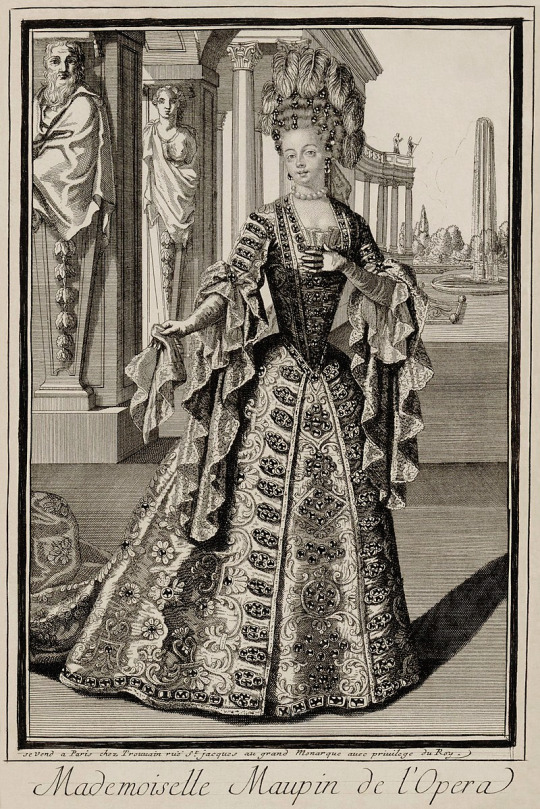
Julie circa 1700 in opera costume.
The most notable source I used:
Julie D'Aubigny: the 17th Century Sapphic Swordfighting Opera Singer, video by Kaz Rowe - I mentioned this before but it bears repeating
Research page by Jim Burrows - This was great since there's gathered multiple sources on le Maupin, historical and more recent, some of which are hard to access fully otherwise
Julie d'Aubigny: La Maupin and Early French Opera, LAPL blog post - It repeats most of the rumors of questionable origin about her as truth, but the sections about her career, which have more backing than just rumors, are really helpful
Mademoiselle De Maupin; Biographical sketches & anecdotes, The Dublin University Magazine - One of those questionable biographies of her from 1854, really only good as a source of what the rumors were after her death
Chevalier, Louis-Joseph, prince de Grimberghen, essay by Neil Jeffares - Biography of count d'Albert, which includes a lot of unsourced rumors about both le Maupin and d'Albert, but recounts his life events in great detail, and references to each claim show which parts are sourced well
#queer history#history#pride month#art#queer art#lgbtq history#sapphic art#digital art#portrait#historical art#historical queer figure#julie d'aubigny#julie de maupin
249 notes
·
View notes
Text









Night rolling in over Schwangau.
Got to check off seeing a mountain sunset on my bucket list. Funny how I wasn't even Canada (my home country) to witness it.
August 25th 2023.
#summer 2023#summertime#Schwangau#Hohenschwangau#Neuschwanstein#countryside#sunset#dusk#golden hour#edge of night#mountside#mountains#nature#driving around#after the rain#Germany#Deutschland#Bavaria#Bayern#Southern Germany#German Alps#night#farmland#greenery#vacation#family vacation#explore#travelling#Europe#Germany trip
6 notes
·
View notes
Text

19 - Wolpertinger
In German folklore, a Wolpertinger (also called Wolperdinger or Woiperdinger) is an animal said to inhabit the alpine forests of Bavaria and Baden-Württemberg in Southern Germany. The most widespread description portrays the Wolpertinger as having the head of a rabbit, the body of a squirrel, the antlers of a deer, and the wings and occasionally the legs of a pheasant. They are part of a larger family of mythical horned mammals that exist throughout the Germanic regions of Europe.
Stuffed "Wolpertingers", composed of parts of actual stuffed animals, are often displayed in inns or sold to tourists as souvenirs in the animal's "native regions". The Deutsches Jagd- und Fischereimuseum in Munich, Germany features a permanent exhibit on the creature.
68 notes
·
View notes
Note
Chronivac Support! Help! I, out of curiosity, started tinkering with settings. I accidentally fucked up the range! It keeps saying “Error: Range at maximum, unable to decrease range at this time. Error code R-408, please contact Chronivac Support”. What’s the maximum range?!? Because I also accidentally hit the “alpha Arab” preset under the popular presets thing!
…so, how badly did I mess things up? Is everyone on my block going to change? Everyone in my neighborhood? Or did I really, really screw things up even more?
Well… What can I say… We already had a quite similar case…
However, I had hoped that after the experience we had there, the possibility of mass changes would have been deactivated… Obviously the automatic update did not work for you. And now we are in trouble! At least I was able to stop all pending transformations. And that were DAMN many!
Unfortunately, there are also a lot of transformations running within a radius of 5,000 km around your location. There are really many of them. In the meantime, I have found out that usually random people were selected for the transformation and this then "infected" people in their immediate vicinity. Here, for example, it hit the chess club of a small town in northern Spain. The transformation has progressed to different degrees. Not everyone has a beard yet… But all are already cut and are on the way to the sunset prayer. When the prayer is over, the man in the middle will be the muezzin of his congregation. And the four other students of a Koran school. With takke on their heads and bushy full beards.

These two guys here worked in Bavaria as social workers in a project for young people. The transformation on the body has only begun, in mind it is already quite far advanced. Neither of them speaks a word of German anymore. At most, they still speak a gibberish that is made up of German, Turkish and Arabic. And they are no longer interested in the socialization of young people. Their lives now take place only between the gym, the shisha bar and the car-tuning garage where they work. It won't be long before they're casually hanging their monstrous arms out of the windows while cruising in their show-off cars.

And really hard hit was this cricket team in Bath in southern England. Not much is left of the snow-white clothing. The audience has also been hit hard. Turkish oil wrestling is on its way to becoming the new English national sport.
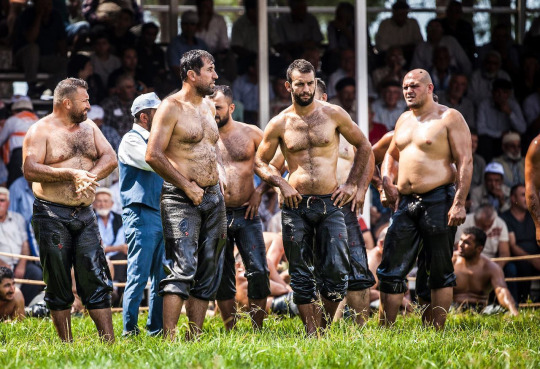
Amazing enough: you are obviously not a bit concerned…. But if you're into cut dicks of Arab alpha stallions, you'll have plenty to choose from in the near future. And I've got a hell of a lot to do to fix the mess you've made.
Pictures are from @lovelyangryheart and @kiffarab
81 notes
·
View notes
Note
In A Guildsman Goes Forth to War, what can you tell us about fae society? I'm assuming they're monarchies, feudal or absolute? Do they bear any resemblance to Celtic society? Do they practice slavery? What of their gender dynamics? Etc
Great question!
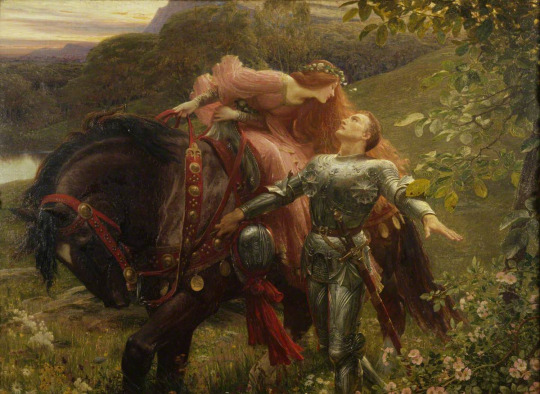
So there's a lot that I'm not going to share with you, because the fae/Fair Folk/etc. are supposed to be a mysterious people who live in their own realm that connects to the human world via thin places in the forests and underhill and deep in the mountains or underground rivers, and humanity doesn't particularly understand them very well despite centuries of intermarriage, as the fae are both very cryptic and contradictory in the information they've shared with their Gentry kin.
Government
As far as humans have been able to glean, the Fae do organize themselves into Courts that seem close enough to European feudal systems that the leading families of Europe can do business with them when it comes to dynastic marriage alliances and diplomatic relations.
That being said, status and power in Faerie society don't seem to be based in land as they are among humans. (In the interests of full disclosure, I'm borrowing some ideas here from the Feywild in D&D.) As far as people have been able to glean from correspondence and diplomatic and cultural interactions, titles are based on elements of nature (the Duke of Hoarfrost, the Viscount of Watermeadows) or from emotions (the Lady of Wistful Rememberance, the Prince of Sorrow), or from ideas and beliefs (the Duchess of the Dark Side of the Moon claims to have once been a handmaiden to the goddess Selene).
Quite a few scholars of geography and history from the leading universities have theories and taxonomies about how Faerie society is organized, but they're all second-hand and can offer only partial explanations and there's absolutely no consensus about what's going on. It does not help that the rare diplomatic missions or marriage parties that go to Faerie from the human world rather than in the other direction tend to report memory issues, such that much of what is recorded owes more to dream logic than accurate observation. Needless to say, this has been a rich vein of material for poets, playwrights, and painters only, and intensely frustrating for academics and statesmen.
Culture
Faerie culture is highly localized in accordance with regional folklore and mythology, although scholars disagree whether human folklore is a record of pre-historical encounters with Faerie, or whether the Fae pattern themselves after the human cultures they interact with.
So for example, the Fae of Éire, Alba, Anglia, and northern Gallia seem to correspond to Gaelic and Brythonic literature, Arthuriana, and the Matters of Britain and France. In the Sacrum Imperium and the Danelaw, however, the dominant Fae cultures are distinctively Germanic and Scandinavian - whether that's the Rheintöchter of the Rhineland and Palatinate, or the dvergr who predominate in Bavaria and the Hapsburg lands or the trollkind and various álfar in the land of the Northmen. In much of southern Europe around the Mediterranean, one is much more likely to encounter Faerie peoples recognizable to students of Greek and Roman mythology: many Gentry from the Lega or the western half of the Rhōmaîoi-Rashidun Federation claim descent from oreads, naiads, nereids, satyrs and other bloodlines.
Human scholars are particularly confused by the fact that all of these different peoples all call one another "cousin," no matter whether they belong to the more humanoid elfkind or the distinctly non-human trollfolk or even the potentially fictional or extinct dragons.
Class and Slavery
As already suggested, Faerie society seems to have some sort of a hierarchy, but it does not seem to be one based in the inheritance of land passed down from generation to generation. Rather, as far as humans can tell, status seems to be associated with proximity to or control of or possession of or identification with magical power from various sources.
What does seem to be the case is that those with more power can command those with less, and Faerie embassies ubiquitously feature both vips with titles and what appear to their servants, but there is no consistency on which kinds of fae serve and which rule. Human visitors and diplomats are very unsure whether this consistutes a caste system or clientilism, because the Fae themselves speak in rather vague terms about "obligations" and "debts" and "true names."
Gender
Again, humans have a rather hard time understanding Faerie gender norms - and are rather unsure whether various Fae kinds have genders and how many they have. What is known is that, among what passes for royalty and nobility in Faerieland, there is a tendency for the female to be announced first - correspondence often arrives in the form of "Queen Titania and King Oberon" or "The Baroness and Baron"- which suggests a slight tendency to the matriarchal, but that is mere supposition. Human cultural conservatives both within and without the Church do grumble about the "immodest" and "amazonian" habits of Faerie women when they comport themselves in their visits to human society or in their Gentry marriages, but they make sure to do so under their breath.
25 notes
·
View notes